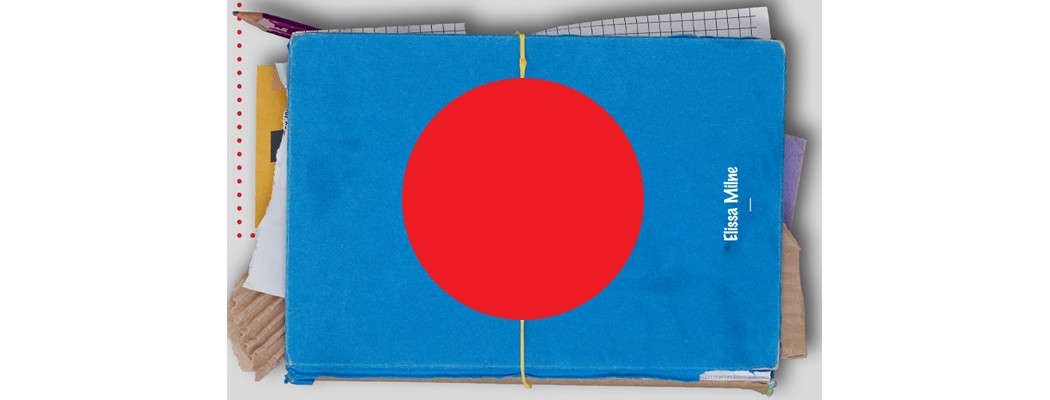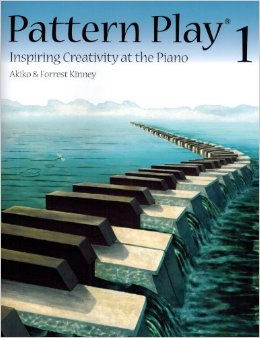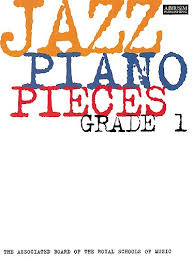A student says ‘I want to play jazz’ and piano teachers the world over think ‘uh oh’. There’s a moment of calm before panic breaks out.
Do they really want to play jazz, thinks the piano teacher, or do they just mean they want to play something that sounds jazzy? Do they really want to improvise, or do they just want to sound like they can? Do they really mean they want to play the blues, or maybe they mean a kind of lounge style? Is this a suggestion from an grandparent or uncle or girlfriend, or does this student have a real interest in the art form? HAS THIS CHILD EVER HEARD REAL JAZZ?!
Lines like ‘don’t play what’s there — play what’s not there’ (Miles Davis) and ‘only play what you hear: if you don’t hear anything, don’t play anything’ (Chick Corea) then compound the piano teacher’s anxiety. When lessons are structured around responding to notation what possible part can jazz play?
And then there’s the issue of accessibility. Of all musical genres none is so child-unfriendly as jazz, with most performances taking place in venues that open well after bedtime and then sell and encourage the consumption of controlled substances.
It’s all very complicated.
Then there are at least ten thousand books out there all telling you they will answer your questions about jazz and teach you how to play it.
No wonder we throw up our hands in horror and murmur something about how Bach’s harmonies are terribly jazzy while assigning another Invention.
So let’s break it down. (Warning: this list is most definitely not comprehensive!)
[infobox maintitle=”Resources to Help you Know More About Jazz/Jazz Piano” subtitle=”” bg=”red” color=”white” opacity=”off” space=”30″ link=”no link”]
Jazz Piano From Scratch by Charles Beale
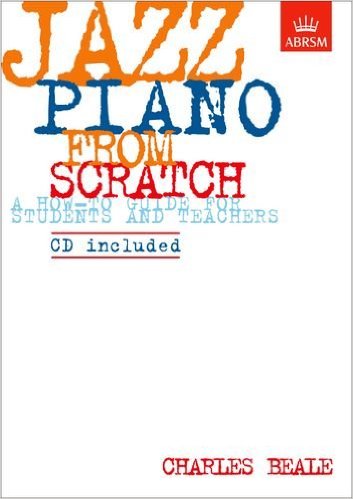
This is for piano teachers who know plenty about classical theory and pianism but not all that much about jazz piano. It works through the basics (the difference between swing and straight grooves, for instance), introduces terminologies (‘turnaround’, ‘changes’, ‘comping’, etc.) that are not used in classical praxis, explores modes and modal harmonies, covers many aspects of improvisation (starting with ‘doodling’), and provides activities and listening suggestions for developing an internalised understanding of jazz at the piano. Included is a CD with nearly 70 examples to further support the text. This book is a must-have if you want your students to take ABRSM Jazz Piano Exams (see over). Published in 1998 it’s not the latest, but it’s a contender in the ‘greatest’ category.
Dick Hyman’s Century of Jazz Piano (Transcribed!)
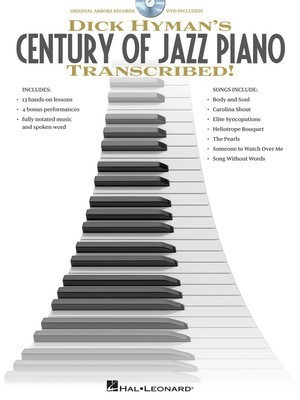
Dick Hyman is a jazz legend. And this book is literally a transcription of his DVD (which is also included) about the history of jazz piano. Starting with The Cakewalk and moving through Boogie Woogie and Stride Piano, Dick Hyman takes pianist-readers on a trip through the 20th century, exploring the development of key elements of jazz.
The book is a series of pieces, each of them a musical example that illustrates the stylistic developments the author is explaining or exploring. You will want to sit at the piano and play your way through this history. Set aside an hour ever y night until you are done! You will finish the book with a deep understanding of not just jazz piano but how the pianism we now think of as being ‘jazz’ developed as an interaction with all the other instruments in the various jazz ensembles. A really brilliant reading/playing/learning experience.
Exploring Jazz Piano Volumes 1 & 2 by Tim Richards

These books are widely considered to be a (if not the) definitive jazz textbook. Tim Richards is a jazz pianist and composer who knows his stuff both as a performer and as a teacher. These books really are an ‘exploration’ of what jazz piano is, covering theory, improvisation, jazz piano history, style, technique — everything.
With improvisation tips and activities for you to perform at the piano, these books are all about immersing the reader in the jazz experience. ‘Knowing’ is something your body does in jazz, not just your brain! And, as is the case in most jazz texts, this book comes with a CD of examples and excerpts so that you are hearing, not just imagining, the real deal. Tim recommends that you use a non-linear approach to these books — don’t get bogged down in one chapter, just move on and come back later. He also points out that the term ‘jazz’ is so broad that he can’t possibly cover the topic comprehensively. (It’s worth knowing that Tim Richards has also authored ‘Exploring Latin Piano’ and ‘Exploring Blues Piano’, if you’re interested in more focussed exploration of these jazz styles). Once you’ve worked your way through these two fantastic volumes, however, I can assure you that you’re going to have a pretty firm grip on what ‘jazz’ might be!
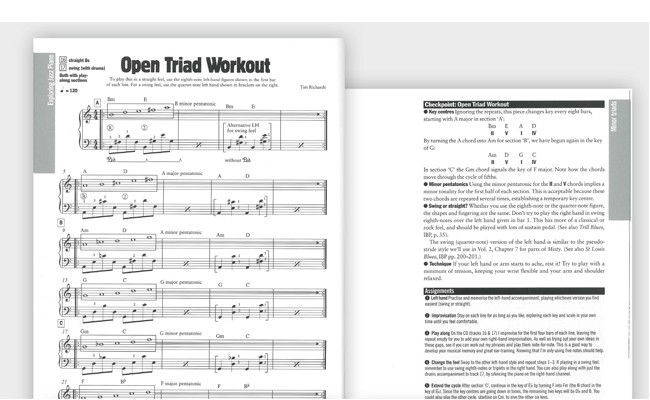
Berklee Jazz Piano by Ray Santisi
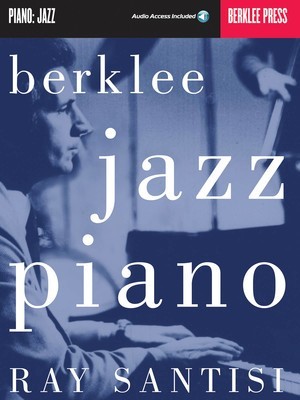
This book is truly fabulous, but if you don’t have any kind of jazz background and you don’t love theory this book might be a bit intimidating without having your own jazz piano teacher. It starts from the basics, and is beautifully clear in both layout and language, but there is an expectation that you will absorb and integrate a lot of harmonic vocabulary at a very fast pace! (The chapters on rhythm take a more measured approach to new information.)
You may or may not like the neologisms like ‘particali-zation’ and ‘pianisticization’, but the ideas are clear and you’ll finish each chapter feeling as if you’re a better musician for having worked your way through it. There’s an appendix of lead sheets with matching, realised etudes, and a third appendix details how this book covers all the minimum departmental requirements for piano majors at Berklee College of Music (one of the most prestigious US musical establishments). And the glossary is, in keeping with the rest of the book, clear and well laid out. CD, of course, included.
Jazz Piano by Liam Noble

Subtitled ‘An In-Depth Look at the Styles of the Masters’, this book is much history book as it is piano music. Biographies and analyses of the styles of 15 great jazz pianists are juxtaposed with a piece (composed by Liam Noble) demonstrating the qualities, techniques and aesthetics of each of these 15 jazz legends. What makes this a must-have in your library is that the accompanying CD includes a play-along version as well as the demonstration performance: you (or your students) can play the written music and have the experience of creating the shapes and stylings of jazz piano’s finest. I promise you will love this book/experience! And that’s not to mention the photos… A fantastic (and comparatively slender!) volume.
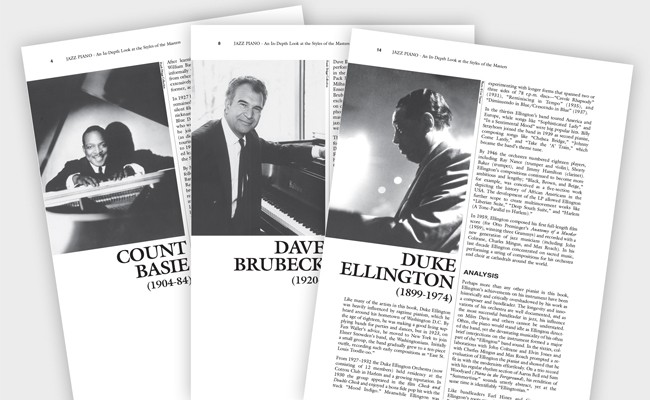
Latin Jazz Piano by John Vallerio
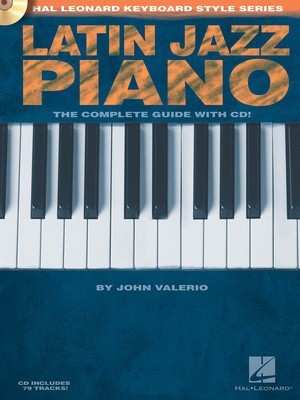
Latin styles are often what people mean when they say ‘jazzy’, and this guide will ensure you feel thoroughly equipped to teach your students the basics of
any number of Afro-Cuban and Brazilian rhythms and styles. You’ll start using terms like ‘clave’ and ‘montuno’ and ‘tumbao’ as if you’ve lived your whole
life in Havana, and you’ll finally know the difference between a mambo and a cha-cha-cha. This is not a thoroughly comprehensive guide, but it’s a focussed start, with lots of written out examples to play through, and 7 play-along tracks on the accompanying CD featuring original tunes in various Latin styles.
[infobox maintitle=”Transcriptions” subtitle=”” bg=”red” color=”white” opacity=”off” space=”30″ link=”no link”]
Transcriptions are to jazz what Urtext editions are to classical music; if you want authenticity in your jazz experience you have to make your own transcriptions of recordings, and study the transcriptions others have made. I can’t help you in the first department (other than recommending some manuscript books), but in the second let me recommend these:
Oscar Peterson: A Jazz Portrait of Frank Sinatra
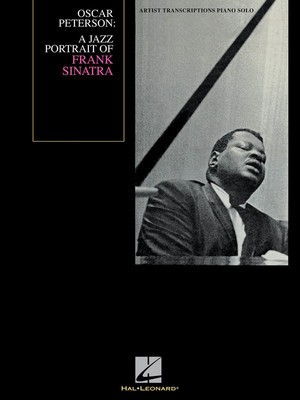
Note-for-note, the way Oscar Peterson played them, a selection of the tunes Frank made his own. If you (or your students) have no experience of transcription this might well be a superb toe-in-the-water repertoire choice: you get to see the way the rhythms and patterns are notated, and can learn them the ‘classical’ way, but don’t just stop there! Go out and start making transcriptions of your own, and see how you go connecting through your ear rather than your eye! You’ll be amazed at how quickly this experience improves your sight-reading.
Modern Jazz Piano by Sarah Cion
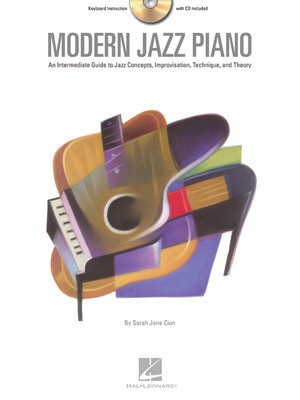
Subtitled ‘An Intermediate Guide to Jazz Concepts, Improvisation, Technique, and Theory’, this really is suitable for use with your teenage students (if you’re looking for such a text) as a transition from classical sonatina and studies type thinking into jazz. With a focus on chords and patterns (theory, really), your classically-based students will feel as if they know what to do, and you’ll feel a clarity about chord indications that you never felt before! The second half of the book is where it all comes together, however: Sarah Jane Cion has provided transcriptions of 15 original tunes, and students can listen to the recording while following the transcription. A transcription isn’t really the same thing as a classical score, so this experience will be fantastic for getting inside the mind-set and performance culture of a jazz pianist. Appropriate for students from roughly Grade 5 standard (minimum) up.
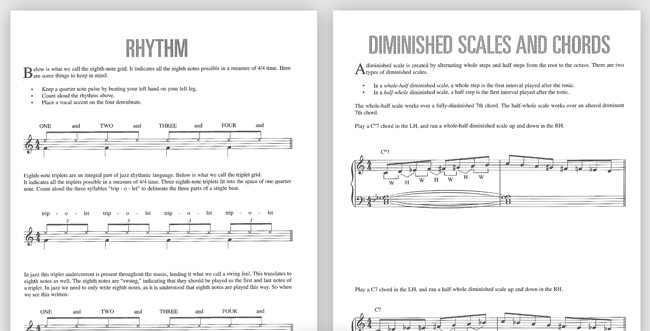
[infobox maintitle=”Resources to help you teach (Jazz) Improvisation” subtitle=”” bg=”red” color=”white” opacity=”off” space=”30″ link=”no link”]
The books I’ve listed previously all have aspects of improvisation-training about them, but the books recommended below are specifically dedicated to help you teach ( jazz) improvisation.
Hal Leonard Student Piano Library Method
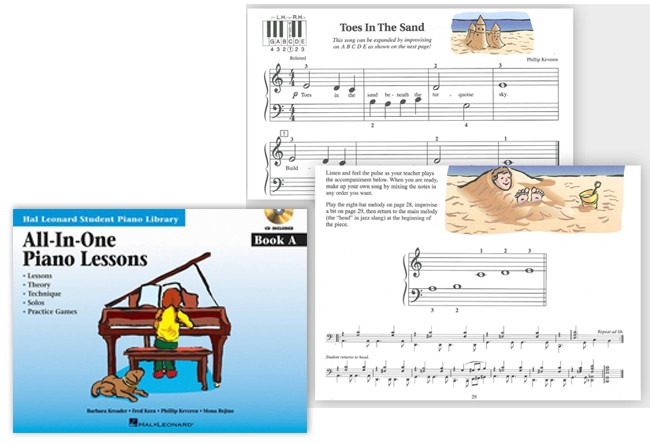
This is a method that asks students to improvise from the very first lesson, and makes it easy for teachers to feel as if they are ‘teaching’ improvisation with all the brilliant accompaniments provided for each improvi-sation activity. Of course, it’s a method designed to take students into the classical repertoire as well, but with a firm foundation in responding creatively to the keyboard, to other musicians, and to music.
Favourite improvising pieces: Toes in the Sand (Phillip Keveren), A Little Latin (Bill Boyd), scales in Lessons 4 My Own Song (improvisation pieces when new concepts are introduced in Lessons Books 3, 4 and 5).
Pattern Play by Akiko and Forrest Kinney
A series you may not have heard of, these 6 volumes create a structured program for learning to improvise at the piano, using duets, solos and composing activities. Part of the goal with these books is to introduce students to a repertoire of patterns, which will make a foundation for successful improvisations. The material is original, but all in a contemporary popular vein, with many of the patterns offered for improvisation being common harmonic shapes from pop music. These books are perfect for those teenagers who think they want to play jazz but have never heard a note of it…
Improvise Microjazz by Christopher Norton

Christopher Norton really is a leader in this field of creating resources for classically-trained piano teachers to teach their students the skill of improvising. Improvise Microjazz was first published in 1988, and it has a blend of fully notated jazz-style pieces and improvisation activities. This book is similar to the American Popular Piano series in conception and in activities, but it’s a stand-alone volume appropriate for Grade 1 or 2 standard students.
American Popular Piano by Christopher Norton & Scott McBride-Smith
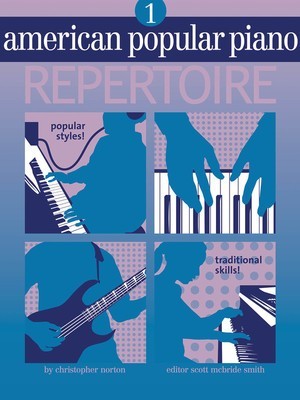
The whole point of this method is to teach students how to be doing it for themselves. Improvisations are the meat in this educational sandwich, with the whole process of developing improvisational skills and insights broken down into tiny, achievable tasks, building confidence in student and teacher alike!
It’s the Etudes book where the magic happens: these ‘etudes’ are actually studies in improvisational thinking, rather than technical exercises. Four modules match a single composition on which the improvisation exercises are based, so students are learning to spend long periods of time immersed in the creative possibilities of a chord pattern or a rhythmic groove. This is a vital element for building great improvisers! Most importantly, every etude assignment begins with the student practising clapping along with a backing track (both a steady beat and a notated pattern). Being able to coordinate with other musicians is key to jazz improvisation, and this series builds students’ capacities and confidence in this regard as much as any other.
Doctor Straight and Mister Swing by Stephan Mehl
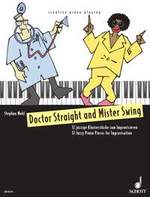
The most fabulous book you’ve never seen before, this volume is surtitled ‘creative piano playing’ and subtitled ‘12 Jazzy Piano Pieces for Improvisation’ — both absolutely accurate descriptions of what lies inside. Each piece has improvisation built into it, but even more exciting, students get training in ways to think about their improvising before they begin, with suggestions for improvising on jazz scales, teacher accompaniments over which students can improvise, and exercises for finessing syncopated rhythms and understanding jazz forms and style.
If you want to teach improvisation to your students, this volume is a must-have, must-use.
Chord Play by Forrest Kinney
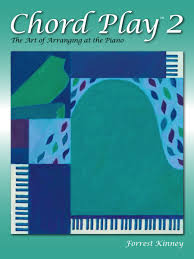
Like Pattern Play, only with an emphasis on reading from a chord chart — these books might be the best introduction to realising charts that classically-trained piano teachers will ever find! Using folk songs, holiday songs and popular songs that have seeped into the fabric of western culture, these books will take students on a sure-footed journey to chord chart competence. An absolute must for any student who wants to play for song services at church, and a superb series for students interested in musical theatre or jamming with their friends. That is, pretty much every student in your studio.
ABRSM Jazz Piano (Grades 1-5, Pieces, Scales,Aural Tests)
If you haven’t taken a look at the ABRSM Jazz Piano publications you’ve been missing out in a major way! A graded, guided system of teaching improvisation that is suitable for children as much as it is for adults (as compared to the textbook-style volumes discussed at the start of this resource file!).
These are absolutely not for your beginner students, and they’re not even for your Grade 1 students (the Grade 1 book is probably perfect for Grade 3 students, maybe a good Grade 2). So don’t tr y to introduce these to your students too soon. But do introduce them! These are graded collections of pieces arranged for solo improvisation in the middle — just like any jazz pianist performance would be — with suggested pitch sets for improvising on, and a structured approach to finishing off the improvisation and returning to the head. There are originals, standards and blues included in each volume, giving your student a nice taste of the variety of jazz styles. These are for the kids who enjoyed their improvising as beginners and now want to get serious about their jazz. The Scale Book is a great additional resource, and you’ll love the Aural Test book — activities that involve improvising and develop musicianship, this book will stand your students in good stead for even straight-laced classical piano exam ear tests!
P Plate Piano – AMEB
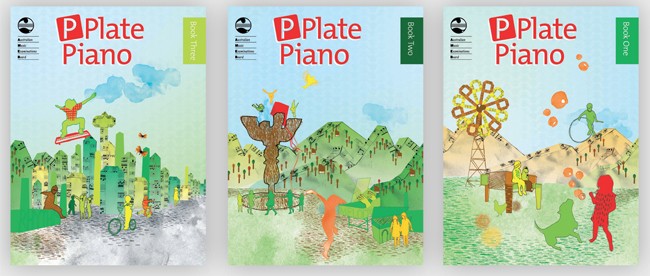
This series takes beginner repertoire as a starting point for keyboard discovery. Students have specific improvising adventures for most of the more than 50 pieces in the three book collection, sometimes exploring dynamics, sometimes register, sometimes articulation, sometimes melodic contour — setting the stage for improvisation to be a normal musical response to anything students experience in the years and repertoire ahead!
